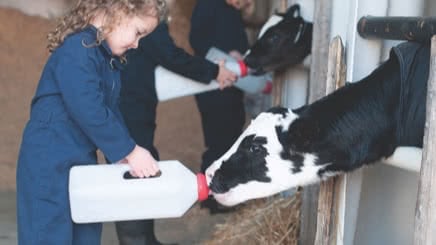CARING FOR COWS
FROM CALF TO COW

Caring for the calf
Like any young animal, the calf will require special attention. Newborns are particularly susceptible to disease, so they're isolated and fed colostrum – the first of their mother's milk which is rich in antibodies – for their first three days.

Preparing for birth
Cows are usually bred at 15 months of age, and after a nine-month pregnancy, they will have their first calf at around two years old. Cows are usually milked for about 10 months and then dried off (milking stops) for two months as they prepare for the birth of their next calf. A cow's gestation period (time from conception to birth) is typically about 285 days, 10 days longer than a human’s.

Caring for the sick
Ontario dairy farmers are required to have a relationship with a licensed veterinarian to help them keep their herd healthy. If a cow is treated with antibiotics, her milk is discarded for a regulated period of time to ensure the medicine has completely cleared her system.

What they eat and drink
Calves are fed milk, or a replacement (like baby formula for calves), until they're ready for solid food, which is gradually introduced into their diet. A full-grown dairy cow will eat about 29 kg of specially formulated feed and drink between 80 and 180 litres of water per day.
DAIRY FARMING MYTHS, DEBUNKED

Are cows over-milked or overworked?
Actually, cows are milked two to three times per day, and for farms with robotic milking, each cow can decide when they want to be milked. They also have the freedom of choosing how many times a day they’re milked (some cows prefer three times a day, some less and some more).

Are cows given “growth hormones” to produce better milk?
No extra hormones are given to dairy cows. They have a natural hormone called BST that helps them produce milk. Plus, rbST, the artificial growth hormone, is strictly prohibited on Canadian dairy farms.

Is there antibiotics in milk?
While there may be times when a veterinarian prescribes antibiotics to help a sick cow get well again, that cow’s milk is discarded for a mandatory period so that they have a chance to fully clear her system. All milk leaving the farm is then tested to verify that there is no trace of antibiotics or other contaminants.

